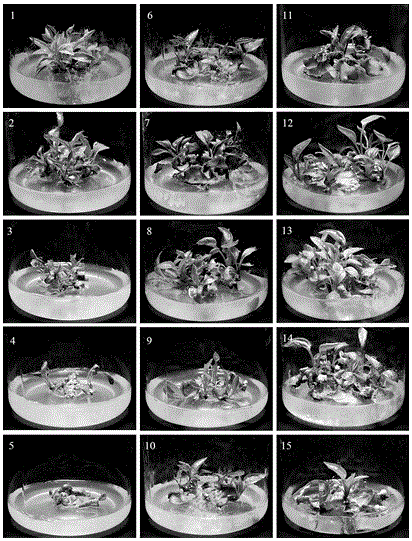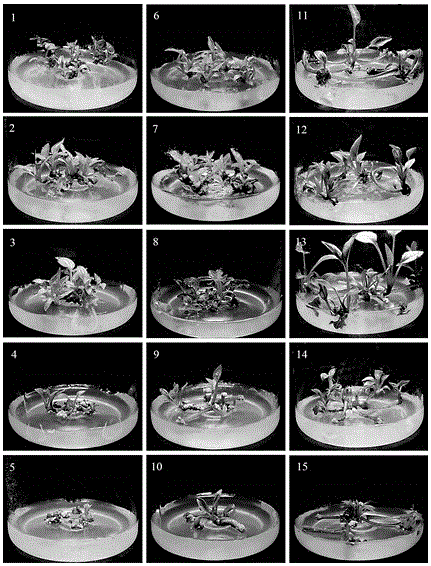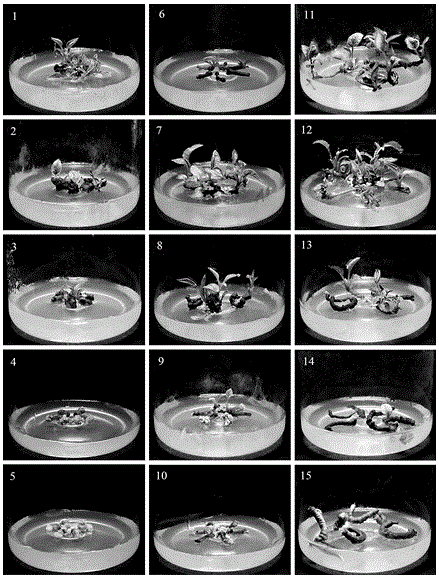Echinacea adventitious bud regeneration culture method
A technology for regenerative culture and regeneration medium, applied in the field of plant biology, can solve problems such as inhibiting the regeneration efficiency of adventitious buds, and achieve the effects of improving the regeneration efficiency of adventitious buds, good economic and social benefits, and broad application prospects.
- Summary
- Abstract
- Description
- Claims
- Application Information
AI Technical Summary
Problems solved by technology
Method used
Image
Examples
Embodiment 1
[0022] 1. Explant preparation: Use scissors to cut several leaves, petioles and roots from the complete Echinacea purpurea seedlings cultured. After rinsing the collected leaves, petioles and roots with tap water for 30 minutes, put all the leaves, petioles and roots in a glass beaker with a capacity of 1000 mL on the ultra-clean workbench, and add 75% ethanol solution to the beaker until all the leaves are submerged. After 1 minute, pour off the ethanol solution, and keep the leaves, petioles and roots; then add 2% sodium hypochlorite solution to the beaker until all the leaves, petioles and roots are submerged. After 20 minutes, pour off the sodium hypochlorite solution, keep the blade, petiole and root; then add sterile distilled water to the beaker until all the leaves, petiole and root are submerged, rinse the blade, petiole and root for 2min, pour off the distilled water, and keep the blade, petiole and root. After rinsing the leaves, petioles and roots with sterile wate...
Embodiment 2
[0028] Experimental method is with embodiment 1, and experimental result is from table 1 and figure 1 It can be seen that leaf explants of different sizes performed differently on the regeneration medium containing DA-6. In all 5 DA-6 concentrations tested, small explants (4 mm × 4 mm = 16 mm 2 ), middle explant (7mm×7mm=49mm 2 ) and large explants (10mm×10mm=100mm 2 ) of adventitious bud induction first increased and then decreased, showing that the addition of appropriate concentration of DA-6 helps to promote the production of adventitious buds on leaf explants, and the concentration of DA-6 required for the best induction efficiency of large explants 0.08mg·L -1 , which is 0.01mg·L higher than the concentration required for the optimal induction rate of small explants -1 .
[0029]
Embodiment 3
[0030] Effect of embodiment 3DA-6 on the regeneration efficiency of petiole explants of different biomass
[0031] Experimental method is with embodiment 1, and experimental result is from table 2 and figure 2 It can be seen that petiole explants of different sizes performed differently on the regeneration medium containing DA-6. Among the five DA-6 concentrations tested, as the concentration of DA-6 increased, the explants of three sizes showed that the induction of adventitious buds first increased and then decreased, that is, adding an appropriate concentration of DA-6 helped To promote adventitious bud formation on petiole explants. The best concentration of large explants is 0.08mg·L -1 , higher than the optimal DA-6 concentration of 0.01mg·L for small explants and medium explants -1 . When the concentration of DA-6 is 0.08mg·L -1 , the adventitious bud induction rate of large explants was at the highest induction rate, but the adventitious bud induction of small ...
PUM
 Login to View More
Login to View More Abstract
Description
Claims
Application Information
 Login to View More
Login to View More - R&D
- Intellectual Property
- Life Sciences
- Materials
- Tech Scout
- Unparalleled Data Quality
- Higher Quality Content
- 60% Fewer Hallucinations
Browse by: Latest US Patents, China's latest patents, Technical Efficacy Thesaurus, Application Domain, Technology Topic, Popular Technical Reports.
© 2025 PatSnap. All rights reserved.Legal|Privacy policy|Modern Slavery Act Transparency Statement|Sitemap|About US| Contact US: help@patsnap.com



